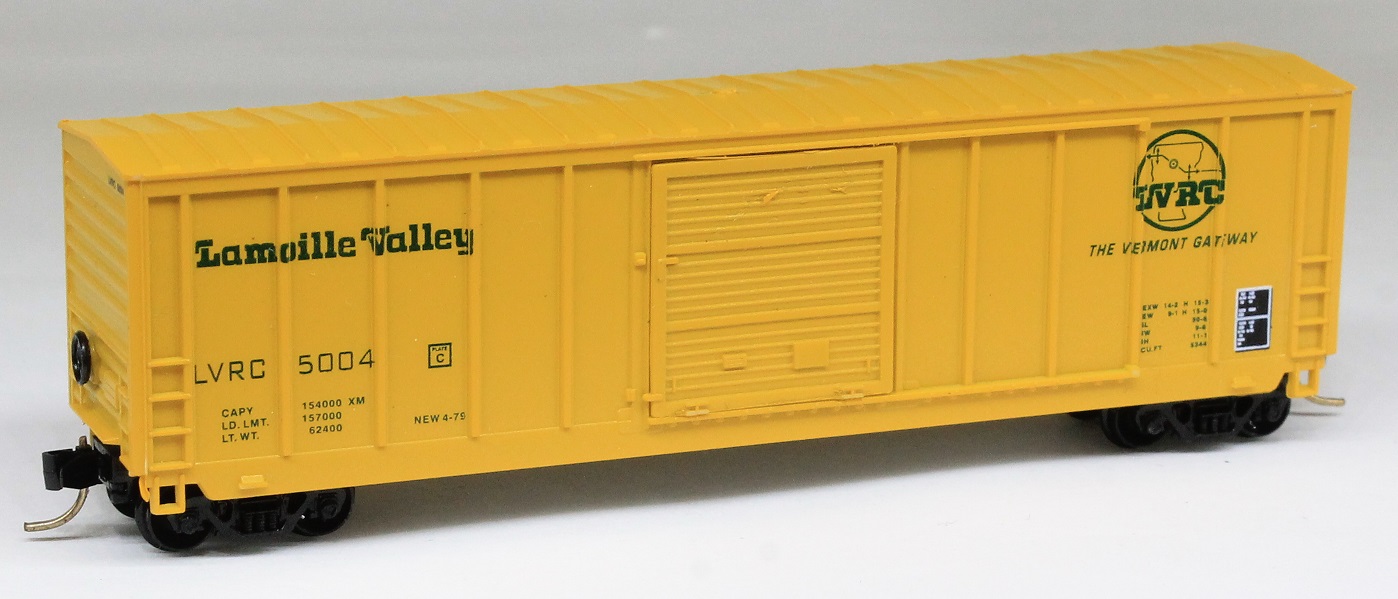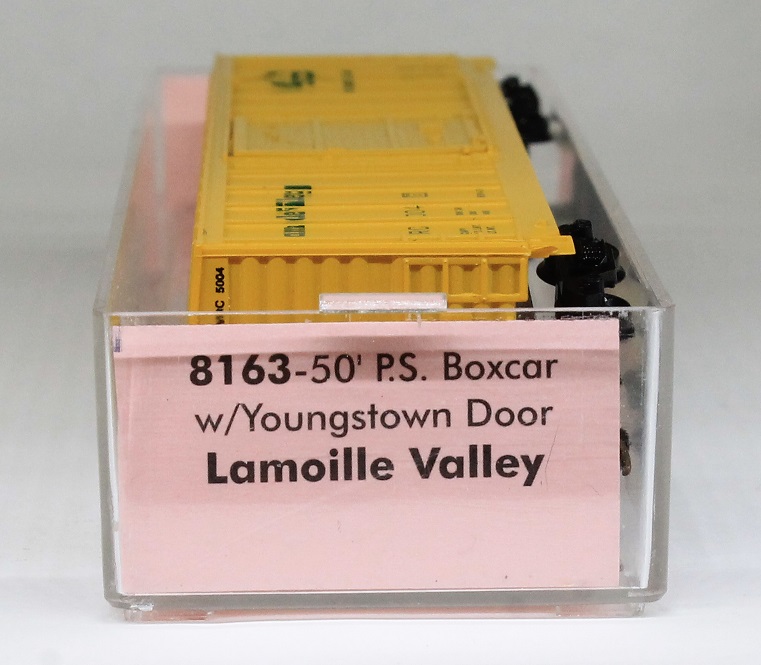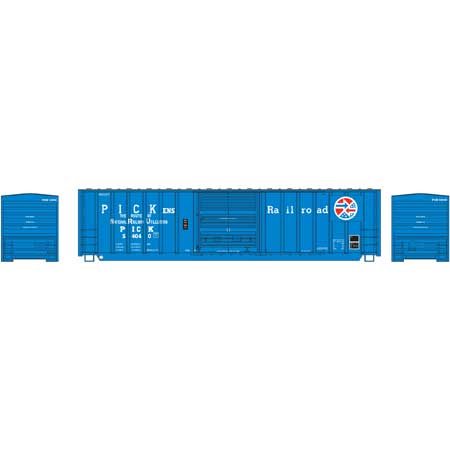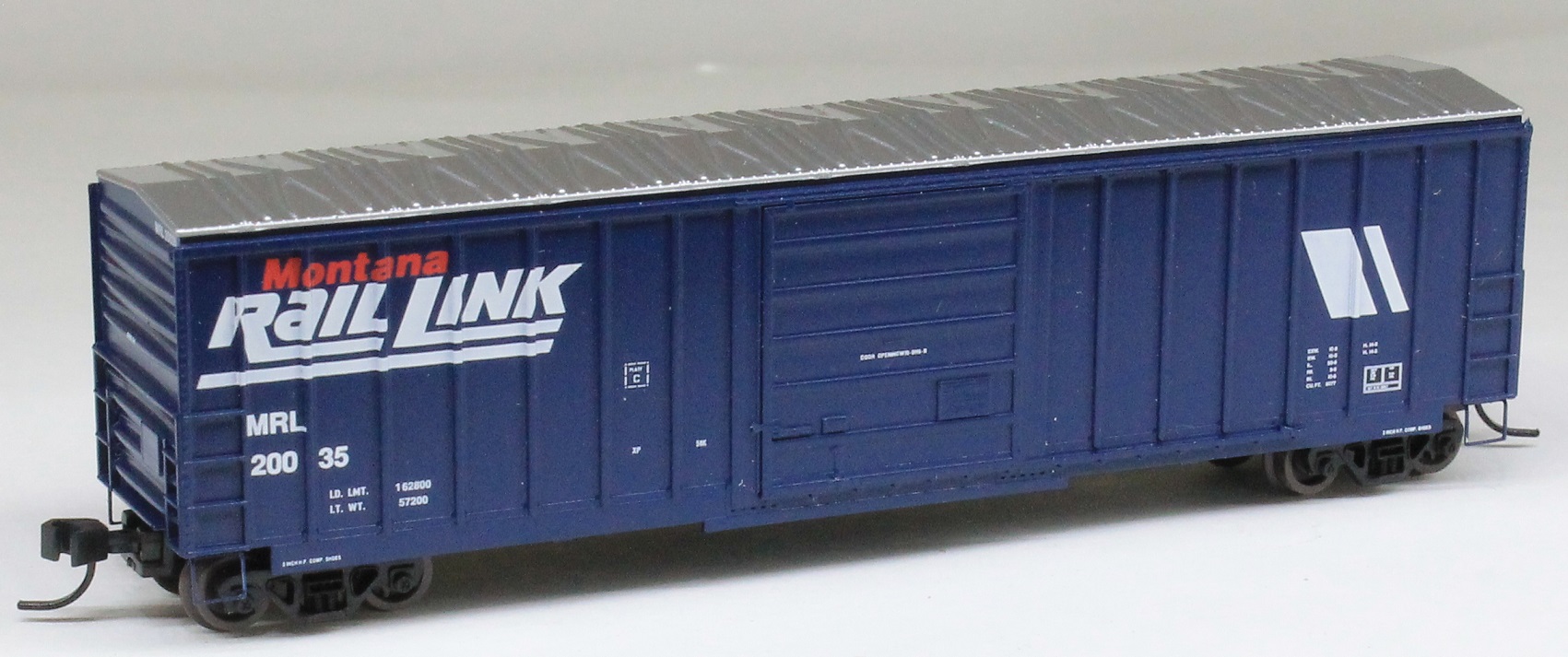Model Information: This MDC Roundhouse body style models a 50 Foot Pullman Standard (PS) Boxcar with a single Youngstown sliding door, Rib Sides, peaked ends, and no roofwalk. The molds were acquired by Athearn/Horizon Hobbies.
Prototype History: The Pullman Standard or PS-1 design was one of the most popular and was widely used by North American railroads. These boxcars were built beginning in 1947 and share the same basic design, with certain elements such as door size, door style or roof type varying among the different railroads and production years. When production of these cars ceased in 1963, over 100,000 had been produced.
The original PS-1 measured 40 foot in length, but Pullman Standard also offered 50′ and later 60′ boxcars – also with the PS-1 designation.
The original PS-1 measured 40 foot in length, but Pullman Standard also offered 50′ and later 60′ boxcars – also with the PS-1 designation.
Road Name History: The 96 miles of track across the top of Vermont has been operated by a number of railroads throughout its history. Up until 1925 it was part of the Boston & Maine. Then it operated as the St. Johnsbury and Lake Champlain. Bankruptcy in 1944 led to a reorganization and a name change to the St. Johnsbury and Lamoille County. Orange and cream GE 70 tonners plied the rails until 1967, when Samuel Pinsley purchased the line on the verge of abandonment. Pinsley family red GP9s and RS3s operated the deteriorating railroad until 1972.
The Lamoille Valley Railroad Company took over operations from the Vermont Northern starting January 1, 1978. The LVRC was given a 10 year lease from the State of Vermont and the money to rebuild the entire 96 mile rail line. In addition, operating subsidies were provided in an effort get the line up and running. Motive power again came from the Delaware & Hudson. Four RS3s were repainted into a yellow with green stripe and lettering scheme. In addition, 100 50' IPD boxcars were leased, painted into the same yellow and green scheme, assuring cars for local shippers.
In 1989, when the B&M (Guilford) sold off its lines in northern New Hampshire (Woodsville to Berlin and Groveton), this trackage plus the Twin State RR and LVRC were acquired by CSF Acquisitions and the entire operation became the New Hampshire & Vermont Railroad. The LVRC ceased as a separate railroad entity, although the line west of St. Johnsbury still retained this name and passenger excursions continued for a few more years. No freight customers existed west of St. J.
Finally the axe fell on the line when the Vermont legislature granted authority to turn the eastern end, Morrisville to St. J, into a snow trail. All rail and ties were pulled up. Fisher Bridge will remain in place. The western section, Morrisville to Sheldon, will be left as is in hopes of restoring rail service and supporting business and the local economy.
From The Northeast Kingdom Railroad
The Lamoille Valley Railroad Company took over operations from the Vermont Northern starting January 1, 1978. The LVRC was given a 10 year lease from the State of Vermont and the money to rebuild the entire 96 mile rail line. In addition, operating subsidies were provided in an effort get the line up and running. Motive power again came from the Delaware & Hudson. Four RS3s were repainted into a yellow with green stripe and lettering scheme. In addition, 100 50' IPD boxcars were leased, painted into the same yellow and green scheme, assuring cars for local shippers.
In 1989, when the B&M (Guilford) sold off its lines in northern New Hampshire (Woodsville to Berlin and Groveton), this trackage plus the Twin State RR and LVRC were acquired by CSF Acquisitions and the entire operation became the New Hampshire & Vermont Railroad. The LVRC ceased as a separate railroad entity, although the line west of St. Johnsbury still retained this name and passenger excursions continued for a few more years. No freight customers existed west of St. J.
Finally the axe fell on the line when the Vermont legislature granted authority to turn the eastern end, Morrisville to St. J, into a snow trail. All rail and ties were pulled up. Fisher Bridge will remain in place. The western section, Morrisville to Sheldon, will be left as is in hopes of restoring rail service and supporting business and the local economy.
From The Northeast Kingdom Railroad
Brand/Importer Information:  MDC Roundhouse was founded in California in 1938 and relocated in 1993 to Carson City, Nevada due to statewide restrictions on painting. MDC Roundhouse was a producer of both RTR (Ready-to-Run) and kit versions of N Scale rolling stock as well as RTR locomotives. They entered the N scale market in 1979 with a Thrall Hi-Side Gondola and a Hi-Cube Single Door Box Car. MDC Roundhouse was purchased by Horizon Hobbies in June of 2004, when its owner since 1938 C. H. Menteer retired, and merged into their Athearn line.
MDC Roundhouse was founded in California in 1938 and relocated in 1993 to Carson City, Nevada due to statewide restrictions on painting. MDC Roundhouse was a producer of both RTR (Ready-to-Run) and kit versions of N Scale rolling stock as well as RTR locomotives. They entered the N scale market in 1979 with a Thrall Hi-Side Gondola and a Hi-Cube Single Door Box Car. MDC Roundhouse was purchased by Horizon Hobbies in June of 2004, when its owner since 1938 C. H. Menteer retired, and merged into their Athearn line.
Unlike many of their contemporaries which contracted with European firms to produce their products, MDC made their own toolings. They made several popular body styles and produced them for road names that many other vendors (even Micro-Trains) wouldn't touch. This made them popular with modelers. Also, their un-assembled "kits" permitted a lower price point so they were popular with "runners" as well as "modelers".
Of particular interest was the attention given to modern 50 foot steel boxcars. They made some attempt to accurately mold the differences into distinct models to represent each of the major prototype manufacturers products. They have distinct toolings not only for the different products from FMC, BFF and PS, but also multiple models for each of these manufacturers including "standard" vs "Youngstown" doors and "waffle" vs. "rib" sides. In total they produced 13 different versions of the 50 foot steel boxcar.

Unlike many of their contemporaries which contracted with European firms to produce their products, MDC made their own toolings. They made several popular body styles and produced them for road names that many other vendors (even Micro-Trains) wouldn't touch. This made them popular with modelers. Also, their un-assembled "kits" permitted a lower price point so they were popular with "runners" as well as "modelers".
Of particular interest was the attention given to modern 50 foot steel boxcars. They made some attempt to accurately mold the differences into distinct models to represent each of the major prototype manufacturers products. They have distinct toolings not only for the different products from FMC, BFF and PS, but also multiple models for each of these manufacturers including "standard" vs "Youngstown" doors and "waffle" vs. "rib" sides. In total they produced 13 different versions of the 50 foot steel boxcar.
Item created by: gdm on 2016-10-13 18:25:50. Last edited by baggedbird on 2023-05-30 17:44:44
If you see errors or missing data in this entry, please feel free to log in and edit it. Anyone with a Gmail account can log in instantly.
If you see errors or missing data in this entry, please feel free to log in and edit it. Anyone with a Gmail account can log in instantly.











